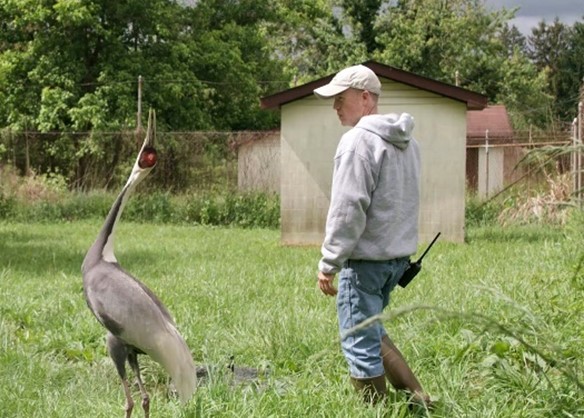White-Naped Crane Dies at the Smithsonian’s National Zoo and Conservation Biology Institute

White-naped crane Walnut and her keeper, Chris Crowe, in 2021.
Credit: Roshan Patel, Smithsonian’s National Zoo and Conservation Biology Institute.
Staff at the Smithsonian’s National Zoo and Conservation Biology Institute’s (NZCBI) campus in Front Royal, Virginia, are mourning the loss of Walnut, a white-naped crane who became an internet sensation for choosing one of her keepers as her mate. At 42 years old, Walnut was considered geriatric for her species. She far surpassed the median life expectancy for white-naped cranes in human care, which is 15 years.
The morning of Jan. 2, keepers noticed Walnut did not eat or drink. To improve her behavior, NZCBI veterinarians administered fluids and antibiotics while they evaluated her bloodwork. Keepers presented Walnut with her diet and favored food items such as frozen-thawed mice, peanuts and mealworms to improve her appetite and encourage her to eat. Unfortunately, she continued to decline and was transported to the hospital, where she died naturally with the animal care team by her side. A necropsy revealed renal failure as the cause of her death.
White-naped cranes are considered vulnerable by the International Union for Conservation of Nature. Today, less than 5,300 remain in their native habitats in Mongolia, Siberia, Korea, Japan and China due to habitat loss, pollution, nest predation and poaching. In the early 1980s, Walnut’s parents were taken from the wild illegally and brought to the United States. They were later rescued by the International Crane Foundation in Wisconsin.
Walnut hatched in Wisconsin in summer 1981 and was named after a local restaurant’s popular walnut pie. Because she was hand-raised by people, Walnut imprinted—or socially bonded—with her caretakers.
As the offspring of two wild-caught cranes, Walnut’s genes were not represented in U.S. zoos. This made her the most genetically valuable crane in the North American population at that time. The Association of Zoos and Aquariums’ Species Survival Plan (SSP) scientists determine which animals to breed by considering their genetic makeup, nutritional and social needs, temperament and overall health. The SSP made several breeding recommendations for Walnut. However, because she was imprinted on humans, she showed no interest in breeding and even attacked her potential mates.
In September 2004, Walnut arrived at NZCBI’s Virginia campus, where scientists regularly breed cranes that have behavioral or physical limitations by using assisted reproduction techniques, including artificial insemination. By observing and mimicking how NZCBI’s male white-naped cranes interacted with their mates during breeding season, bird keeper Chris Crowe gained Walnut’s elusive trust. He pair-bonded with her by flapping his arms in a manner similar to the species’ unison dance, offered her nesting materials and brought her food. Once she was receptive to breeding, Crowe was able to use sperm collected from a male crane to artificially inseminate Walnut without the need for physical restraint.
From 2005 to 2020, she successfully contributed eight offspring to her species’ survival. To give Walnut’s chicks the best chance of survival, keepers gave her fertile eggs to other white-naped crane pairs, who raised the chicks as their own. Of the eight white-naped cranes that currently live at NZCBI, two are related to Walnut—her first chick, an 18-year-old female named Brenda, and Brenda’s 1-year-old female chick, who has not received a name yet. Many of Walnut’s chicks have reached adulthood, and several have successfully bred naturally and cared for offspring with their mates.
“Walnut was a unique individual with a vivacious personality,” Crowe said. “She was always confident in expressing herself, an eager and excellent dancer, and stoic in the face of life’s challenges. I’ll always be grateful for her bond with me. Walnut’s extraordinary story has helped bring attention to her vulnerable species’ plight. I hope that everyone who was touched by her story understands that her species’ survival depends on our ability and desire to protect wetland habitats.”
Observing the behavior of Walnut and other white-naped cranes gave NZCBI’s bird team valuable insight into crane courtship displays, vocalizations, breeding behaviors and parenting—including incubation and chick-rearing duties. Walnut’s contributions to her species’ survival helped add to scientists’ knowledge about imprinting and artificial insemination in individuals that have behavioral or physical limitations.
The Smithsonian’s National Zoo and Conservation Biology Institute leads the Smithsonian’s global effort to save species, better understand ecosystems and train future generations of conservationists. Its two campuses are home to more than 2,300 animals, including some of the world’s most critically endangered species. Always free of charge, the Zoo’s 163-acre park in the heart of Washington, D.C., features 2,100 animals representing 400 species and is a popular destination for children and families. At the Conservation Biology Institute’s 3,200-acre campus in Virginia, breeding and veterinary research on 250 animals representing 20 species provide critical data for the management of animals in human care and valuable insights for conservation of wild populations. NZCBI’s 305 staff and scientists work in Washington, D.C., Virginia and with partners at field sites across the United States and in more than 30 countries to save wildlife, collaborate with communities and conserve native habitats. NZCBI is a long-standing accredited member of the Association of Zoos and Aquariums.
# # #
SI-45-2024
